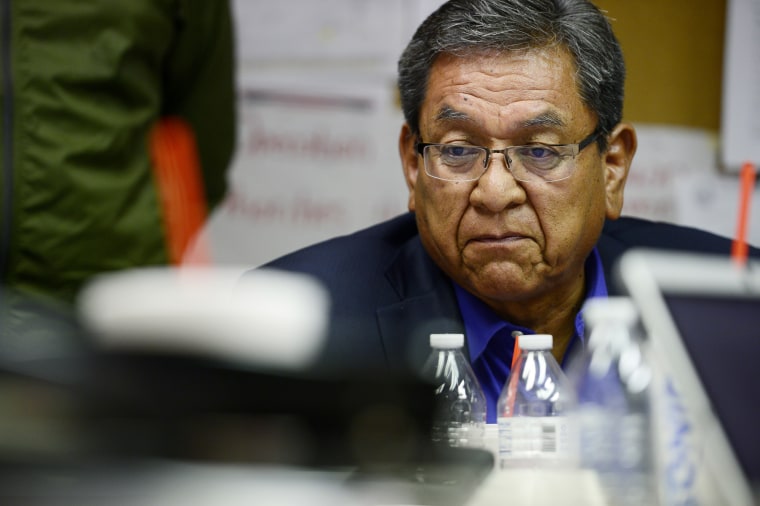The biggest coal-burning power plant in the West is fighting for survival — and despite support from the Trump administration and Republicans in Congress, it appears likely to close next year.
The Navajo Generating Station in northern Arizona is a centerpiece of the economy on the largest Native American reservation in the country, providing hundreds of jobs. But the power plant is also struggling to stay open as local utilities that use its power turn to cheaper, greener energy sources, and it would need a new owner if it’s to continue operating.
With the search for an owner stalled and time running short before the plant’s current operating deal expires in December 2019, a crucial tribal leader has joined a chorus of those saying the plant is unlikely to survive.
“Right now all the indicators are this plant is going to shut down. It’s going to be decommissioned,” Russell Begaye, president of the Navajo Nation, said in an interview.
The Navajo Generating Station has polluted the skies over the reservation for decades, but it’s also been key to the financial well-being of the Navajo and neighboring Hopi tribes. The two tribes share in the royalties from the Kayenta coal mine, which supplies the power plant, and also faces closure. The Navajo government gets 22 percent of its revenue from the operation, while the Hopi’s budget is more than 85 percent dependent on coal power. The power plant and the mine also provide 725 jobs, most of them filled by Navajos.
The fate of the power plant is an important test case of President Donald Trump’s promise to preserve coal jobs.
Peabody Energy, the biggest coal miner in the U.S., and its investment banking firm, Lazard, are leading the fight to keep the Navajo Generating Station open. Peabody, which runs the Kayenta mine, has been working with Trump’s Interior Department to try to find utilities or other customers to take the plant’s power, agreements that would make the plant more attractive to a new owner. The Environmental Protection Agency has helped out, too, agreeing to accept a less expensive plan for controlling emissions from the plant, according to a Lazard representative.
The White House did not immediately respond to a request for comment.
The 44-year-old power plant, which helps light the Southwest and powers the pumps that send Colorado River water to Tucson and Phoenix, has been the most heavily polluting coal-fired electricity producer in the West. The Sierra Club and other environmental groups have been pushing to close it.

Begaye's comments were noteworthy, first because he had previously spoken with more optimism about keeping the generating station open and second because his remarks broke from the "unified voice" that coal mine representatives have said is needed in their campaign to prolong the life of the power plant.
Begaye says he believes Peabody’s efforts and the federal government’s assistance won’t be enough to reverse the market forces pushing utilities away from coal. He has criticized the Trump administration for failing to do more to save the Navajo Generating Station, saying in an interview with NBC News last year that the administration had created “a lot of thunder, no rain” in their support of the power plant and coal mine. In his more recent remarks, Begaye added that potential operators of the power plant “are not buying what is being said from the White House.”
The tribal leader also flatly rejected another idea designed to make NGS power cheaper and thus more attractive to potential new owners: lowering the royalties that Peabody pays to the Navajo and Hopi for their coal. Begaye said his tribe has been asked too many times in the past to make concessions that allow outsiders to tap its rich natural resources.

Coal-generated electricity has been in retreat around America, as hydraulic fracturing (or “fracking”) has lowered the price of natural gas and as utilities increasingly turn to renewable power sources. Doubts about the future of NGS have grown because Peabody has not been able to deliver on its pledge, made six months ago, to line up a new power plant operator by the end of the first quarter of 2018. That date passed last week, without a successor being named.
Peabody, though, says it is still confident about finding a new owner for the power plant. “We are encouraged by the progress Lazard is making to support the transition of the plant to new owners and will continue working with stakeholders to advance all possible steps to keep the plant online well beyond 2019,” the mining company said in a statement.
One reason Lazard and Peabody are hopeful is because of their political allies. They predicted that Arizona state regulators will require that state utilities planning to abandon the coal plant keep getting electricity there. There’s no indication that will happen anytime soon. But the arguments in favor of the plant’s survival will be heard in Washington this week. On Thursday, the House Natural Resources Subcommittee on Energy and Mineral Resources will hold a hearing on the benefits of the 2,250-megawatt Navajo Generating Station.
Begaye, though, believes the Navajo’s dependence on industries like coal will ultimately come to an end. "We will make a shift away from natural resource dependency," said Begaye, noting the tribe hopes to turn to technology instead. “We are in a very exciting time for [the] Navajo."
